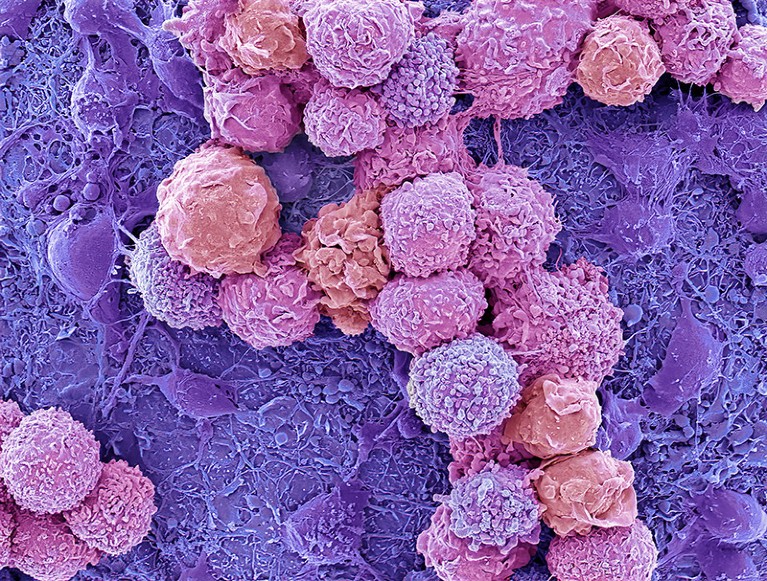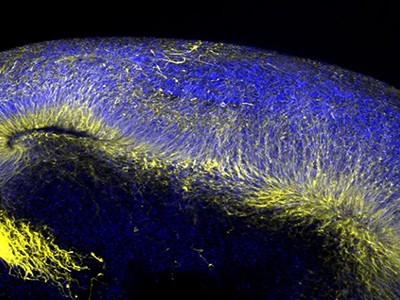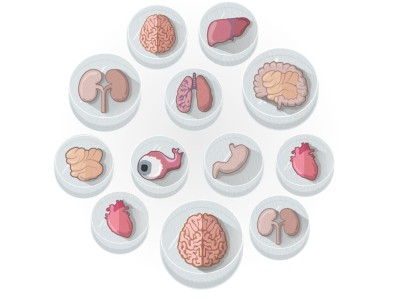
Part of a brain organoid, in which stem cells (pink) are differentiating into neurons (purple).Credit: Steve Gschmeissner/Science Photo Library
Researchers have built a hybrid biocomputer that combines a laboratory-grown human brain tissue with conventional circuits, and can complete tasks such as voice recognition.
The technology, described on 11 December in Nature Electronics1, could one day be integrated into artificial-intelligence (AI) systems, or form the basis of improved models of the brain in neuroscience research.
Organoids open fresh paths to biomedical advances
Researchers call the system Brainoware. It incorporates brain organoids — bundles of tissue-mimicking human cells that are used in research to model organs. Organoids are made from stem cells capable of specialising into different types of cells. In this case, they were morphed into neurons, akin to those found in our brains.
The research aims to build “a bridge between AI and organoids”, says study co-author Feng Guo, a bioengineer at the University of Indiana in Bloomington, Indiana. Both AI and the brain rely on passing signals around a web of interconnected nodes, known as a neural network. “We wanted to ask the question of whether we can leverage the biological neural network within the brain organoid for computing,” he says.
Harnessing brainpower
To make the Brainoware system, researchers place a single organoid onto a plate containing thousands of electrodes to connect the brain to electric circuits. They then translate the information they want to input into a pattern of electric pulses that they deliver to the organoid. The brain tissue’s response is picked up by a sensor and ‘decoded’ using a machine-learning algorithm that can identify the information it relates to.
To test Brainoware’s capabilities, the team used this technique to do voice recognition by training the system on 240 recordings of eight people speaking, translating the audio into electric to deliver to the organoid. The mini brain reacted differently to each voice, generating a different pattern of neural activity. The AI learned to interpret these responses to identify the speaker. After training, the system could identify voices with an accuracy of 78%.
Although much more research is needed, the study confirms some key theoretical ideas that could eventually make a biological computer possible, says Lena Smirnova, a developmental neuroscientist at John Hopkins University in Baltimore, Maryland. Previous experiments have shown only two-dimensional cultures of neuron cells to be able to perform similar tasks, but this is the first time it has been shown in a three-dimensional brain organoid.
Better brain model
Combining organoids and computers could allow researchers to leverage the speed and energy efficiency of human brains for AI, says Guo.
The boom in mini stomachs, brains, breasts, kidneys and more
The technology could also be used to study the brain, says Arti Ahluwalia, a biomedical engineer at the University of Pisa in Italy, because brain organoids can replicate the architecture and function of a working brain in ways that simple cell cultures cannot. There is potential to use Brainoware to model and studying neurological disorders, such as Alzheimer’s disease. It could also be possible to test the effects and toxicities of different treatments by seeing how the organoids react. “That’s where the promise is; using these to one day hopefully replace animal models of the brain”, says Ahluwalia.
But using living cells for computing is not without its problems. One big issue is how to keep the organoids alive. The cells must be grown and maintained with incubators, something that will be harder to achieve the bigger the organoids get. And more complex tasks will demand larger ‘brains’ , says Smirnova.
To build upon Brainoware’s capabilities, Guo says the next steps include investigating whether and how brain organoids can be adapted to complete more complex tasks, and engineering them to be more stable and reliable. This will be crucial if they are to be incorporated into the silicon microchips currently used in AI computing, he says.





